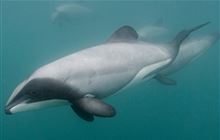Second dead Hector’s dolphin West Coast
Archived content: This media release was accurate on the date of publication.
Introduction
A dead Hector’s dolphin has been found on the West Coast today, exactly a week after one was found further south.Date: 25 February 2022
This morning a member of the public contacted the Department of Conservation (DOC) after finding a dead dolphin at Rapahoe Beach, near Point Elizabeth north of Greymouth.
“The dolphin found today was a calf, less than a metre long. It appeared to have died recently and there were no visible marks to indicate cause of death,” DOC Aquatic Director Elizabeth Heeg says.
She thanked the person who found the calf for contacting DOC so rapidly.
The report was made at 9.18 am. By 11.30 am Greymouth DOC staff had collected the dolphin and it was being held chilled in their offices.
“We’re really grateful that the public is heeding the message and reporting Hector’s dolphins when they are found.
“It will be sent to Massey University for necropsy. Every find is a valuable key to learning more about the species and the threats they face.”
Elizabeth Heeg says over this summer Hector’s dolphins, including calves, have been sighted frequently very close to shore near Greymouth.
On 18 February DOC was contacted by a person who had found a dead Hector’s dolphin calf at Mikonui Beach, south of Hokitika.
Information from the necropsies of both dolphins will be uploaded to DOC’s Hector’s and Māui dolphin incident database and to the DOC website during the next scheduled update in early May.
Anyone finding a dead Hector’s or Māui dolphin is urged to report it to DOC via 0800 DOC HOT. It is also important for the public to report live sightings via the DOC webpage, or the hotline.
Other information
Hector’s dolphins are the world’s smallest dolphin species, with adults measuring about 1.5 m long.
Identifiable through their distinctive round dorsal fins, Hector’s dolphins’ bodies are grey with black and white markings. The population is estimated to be around 15,000 and they are classified as Nationally Vulnerable in the National Threat Classification System.
Hector’s and Māui dolphin bodies are routinely sent to Massey University for necropsy to obtain information such as cause of death (when this can be determined), including examination for disease. Information on the sex, body condition and other biological information is also recorded. The level of decomposition of a dolphin carcass, and whether it has been frozen, are key factors in how much information can be determined.
Incidents involving Hector’s and Māui dolphins are recorded on a database based on reported events. These include live stranded animals, dolphins found dead on beaches, injured at sea, found floating dead in the ocean, or caught as part of recreational or commercial fishing. This data is shared online, along with any necropsy reports, on a quarterly basis.
The work to protect both Hector’s and Māui dolphins is guided by the Hector’s and Māui Dolphins Threat Management Plan.
Contact
For media enquiries contact:
Email: media@doc.govt.nz

